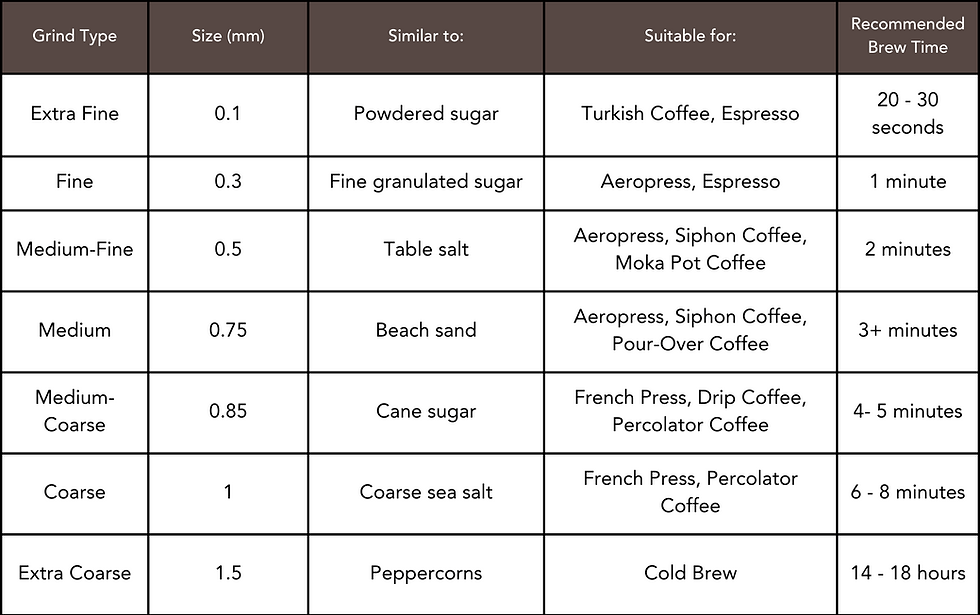Coffee Grind Size – Perfecting Your Brew
- Six Four Coffee

- Nov 30, 2023
- 3 min read
Updated: Nov 4, 2024

Brewing your coffee from scratch means going through a couple extra steps and spending a little more time to make sure that everything is down to a 'T' before beginning the brew. Details like using the right temperature of water, the right amount of beans and grinding them to the ideal size are essential to achieving that perfect cuppa.
Among the various steps involved in the brewing process, grinding the coffee bean is arguably the most important step because the size and consistency of the grind play a crucial role in determining the rate of extraction, which directly impacts the flavour, strength, and overall quality of your brew. Hence, coffee grind size can make all the difference in your brew – it can unlock the full spectrum of flavours and aromas within the bean – or produce a cup of less-than-satisfactory brew.
What is Grind Size and Why it Matters
To start with, grinding coffee beans allows for the extraction of soluble compounds within the bean that give us the delightful flavours and aromas we associate with fresh coffee. Put simply, grind size can then be defined as how fine or coarse the coffee beans are ground to. Finer grinds expose a larger overall surface area than coarser grinds. This distinction affects three key aspects of the coffee brewing process, namely: contact time, extraction rate and flow rate. Finer grinds, while resulting in a slower flow rate, allow for a shorter contact time with water. The end result is generally a faster extraction for finer grinds.
A Quick Guide to Grind Size
While there are no strict rules dictating which grind size is the best for each brewing method coffee grind size, some grind sizes are better suited to specific brewing methods.
Extra Coarse: The largest grind size, resembling peppercorns, is perfect for brews that require a long amount of time for extraction. This makes extra coarse coffee grounds ideal for cold brews as the extended extraction process benefits from the easy filtering of these chunky grounds.
Coarse: Slightly finer than extra coarse, with a look resembling coarse sea salt, it suits French press, percolators, and coffee cupping methods, giving a robust brew.
Medium Coarse: With a consistency that resembles cane sugar, medium coarse grounds cater to cafe solo or clever drippers, given that it requires less extraction time than cold brew or French press. However, this grind size can also be used for French press, drip coffee and percolator coffee.
Medium: A go-to for regular drip coffee, siphon coffee and pour-over coffee. The medium grind, akin to beach sand, is a staple in many coffee shops.
Medium Fine: This grind resembles table salt and it provides a balance between drip coffee and espresso size. It suits pour-over methods, providing versatility across brewing styles including siphon coffee and moka pot coffee.
Fine: Common in pre-ground coffee and espresso at coffee shops, fine grounds resemble fine granulated sugar for a balanced extraction. This grind size is most suitable for making coffee via espresso.
Extra Fine: Akin to powdered sugar in consistency, extra fine grinds are perfect for enthusiasts of bold Turkish coffee or espresso as it deliver a powerful and intense brew.
Here is a handy table for easy reference of which grind size is most suitable for which type of coffee:

Let’s Not Forget Grind Consistency
As mentioned earlier, a finer grind size exposes more flavours and faster. When a grinder gives an output that contains not just the desired grind size, but a substantial amount of finer grounds, you tend to get a less ideal representation of the coffee. The finer grounds are steeped longer than they should and may end up releasing the more bitter flavour compounds as well. On the flip side, An inconsistent grinder may also produce an output that contains some coarser grounds, meaning that the resulting coffee is weaker than it’s supposed to be.
In summary, grind size matters because it directly affects the coffee brewing process in terms of how long you should brew, how quickly are flavours extracted, and how fast water flows through them. All of these impact the taste and quality of your coffee. If you find that your coffee tastes watery and acidic, you may be grinding your beans too coarsely. Try a finer grind, and see if that fixes the issue. And if your coffee tastes overly bitter, you may be grinding too finely. A coarser grind may improve your brew. Try experimenting with different grind sizes to see what works best for you!
Ready to elevate your coffee experience? Explore our range of grinders for the perfect grind every time: https://www.sixfourcoffee.com/coffeemachines
.png)



Comments